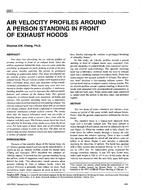Description
Notes that few data exist describing the air velocity profiles of persons working in front of an exhaust hood. Since the airflow originates behind the body, concern exists about the possibility of stagnant air pools forming in front of the face and chest, thereby exposing the person to prolonged breathing of undesirable fumes. Presents a study investigating the air velocity profiles around a person standing in front of exhaust hoods. The air velocity profiles were mapped at four sites – overhead, head chest and abdomen – using omnidirectional anemometers. White smoke tests further depicted the pattern of flow. A stationary, standing manikin was used to represent a person. Two general categories of exhaust hood were examined – enclosing and exterior. Presents and discusses the results, which show that the typical laboratory was successful in keeping fumes away from a person’s face, even with the window sash fully open. The kitchen canopy hood was much less effective in directing smoke away from the facial area. For both types of hood there was no persistent pool of stagnation created in front of the face.
KEYWORDS: Air flow, speed, exhaust hoods, research, manikins, fumes, laboratories, kitchens, people
Citation: ASHRAE Trans. 1994, vol.100, part 2, paper number 3827, 439-447, 10 figs, 3 tabs, refs.
Product Details
- Published:
- 1994
- File Size:
- 1 file , 2.2 MB
- Product Code(s):
- D-17459




